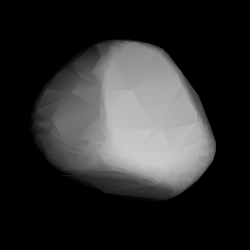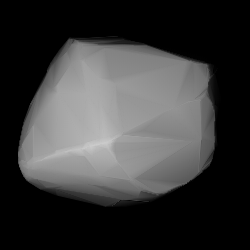Related Research Articles

1054 Forsytia is a dark background asteroid, approximately 46 kilometers in diameter, from the outer regions of the asteroid belt. It was discovered on 20 November 1925, by astronomer Karl Reinmuth at the Heidelberg-Königstuhl State Observatory in southwest Germany and assigned provisional designation 1925 WD. It is named after the flowering plant forsythia, and marks the beginning of a sequence of 28 thematically named asteroids by the discoverer.
1066 Lobelia, provisional designation 1926 RA, is a bright background asteroid from the inner regions of the asteroid belt, approximately 6 kilometers in diameter. It was discovered on 1 September 1926, by astronomer Karl Reinmuth at the Heidelberg-Königstuhl State Observatory in Germany. The asteroid was named after the flowering plant Lobelia (lobelias).
1067 Lunaria, provisional designation 1926 RG, is a stony Itha asteroid from the outer regions of the asteroid belt, approximately 18 kilometers in diameter. It was discovered on 9 September 1926, by astronomer Karl Reinmuth at the Heidelberg-Königstuhl State Observatory in southwest Germany. The asteroid was named after the flowering plant Lunaria (honesty).
1070 Tunica, provisional designation 1926 RB, is a dark background asteroid from the outer regions of the asteroid belt, approximately 35 kilometers in diameter. It was discovered on 1 September 1926, by German astronomer Karl Reinmuth at the Heidelberg-Königstuhl State Observatory in southwest Germany. The asteroid was named after Petrorhagia, a flowering plant also known as "Tunica".
1076 Viola, provisional designation 1926 TE, is a Nysian asteroid from the inner regions of the asteroid belt, approximately 22 kilometers in diameter. It was discovered on 5 October 1926, by German astronomer Karl Reinmuth at the Heidelberg Observatory in southwest Germany. The asteroid was named after the flowering plant Viola.

1077 Campanula, provisional designation 1926 TK, is a presumed Erigonian asteroid, approximately 9 kilometers in diameter, located in the inner region of the asteroid belt. It was discovered on 6 October 1926, by German astronomer Karl Reinmuth at the Heidelberg Observatory in southwest Germany. The asteroid was named after the bellflower Campanula.
1078 Mentha, provisional designation 1926 XB, is a stony background asteroid from the inner regions of the asteroid belt, approximately 13 kilometers in diameter. It was discovered on 7 December 1926, by astronomer Karl Reinmuth at the Heidelberg-Königstuhl State Observatory in southwest Germany. Only in 1958, it was realized that this object was a rediscovery of an already numbered but lost asteroid.

1080 Orchis, provisional designation 1927 QB, is an dark background asteroid from the inner regions of the asteroid belt. It was discovered on 30 August 1927, by German astronomer Karl Reinmuth at the Heidelberg Observatory in southwest Germany. The carbonaceous F-type asteroid has a rotation period of 16.1 hours and measures approximately 22 kilometers in diameter. It was named after the flowering plant Orchis.

1081 Reseda is a dark background asteroid from the outer regions of the asteroid belt. It was discovered on 31 August 1927, by astronomer Karl Reinmuth at the Heidelberg-Königstuhl State Observatory in southwest Germany. The asteroid has a rotation period of 7.3 hours and measures approximately 37 kilometers in diameter. It was named after the herbaceous plant Reseda.
1085 Amaryllis, provisional designation 1927 QH, is a background asteroid from the outer regions of the asteroid belt, approximately 69 kilometers in diameter. It was discovered on 31 August 1927, by astronomer Karl Reinmuth at the Heidelberg-Königstuhl State Observatory in southwest Germany. The asteroid was named after the flowering plant Amaryllis.

1087 Arabis is a stony Eoan asteroid from the outer regions of the asteroid belt, approximately 35 kilometers in diameter. It was discovered by Karl Reinmuth at the Heidelberg Observatory in 1927 and assigned the provisional designation 1927 RD. The asteroid was named after the flowering plant Arabis (rockcress).
1091 Spiraea, provisional designation 1928 DT, is a carbonaceous Cybele asteroid from the outer regions of the asteroid belt, approximately 36 kilometers in diameter. It was discovered on 26 February 1928, by astronomer Karl Reinmuth at the Heidelberg-Königstuhl State Observatory in southwest Germany. The asteroid was named after Spiraea, a genus of plants.
1092 Lilium, provisional designation 1924 PN, is a dark, carbonaceous background asteroid from the outer regions of the asteroid belt, approximately 44 kilometers in diameter. It was discovered on 12 January 1924, by German astronomer Karl Reinmuth at the Heidelberg Observatory in southwest Germany. The asteroid was named after the flower Lilium.

1095 Tulipa is an Eos asteroid from the outer regions of the asteroid belt. It was discovered by German astronomer Karl Reinmuth at the Heidelberg-Königstuhl State Observatory in southwest Germany on 14 April 1926. The assumed S-type asteroid has a rotation period of 2.8 hours and measures approximately 30 kilometers in diameter. It was named after the flower Tulip. Originally, the name was redundantly assigned to Florian asteroid 1449 Virtanen.
1104 Syringa, provisional designation 1928 XA, is a dark background asteroid from the central regions of the asteroid belt, approximately 23 kilometers in diameter. It was discovered on 9 December 1928, by German astronomer Karl Reinmuth at the Heidelberg-Königstuhl State Observatory in southwest Germany. The asteroid was named after the flowering plant Syringa (lilac).

1105 Fragaria is an Eos asteroid from the outer regions of the asteroid belt. It was discovered on 1 January 1929, by German astronomer Karl Reinmuth at the Heidelberg Observatory in southwest Germany, and assigned the provisional designation 1929 AB. The S-type asteroid (ST/L) has a rotation period of 5.4 hours and measures approximately 37 kilometers in diameter. It was named after the flowering plant Fragaria (strawberry).
1232 Cortusa, provisional designation 1931 TF2, is a background asteroid from the outer regions of the asteroid belt, approximately 40 kilometers (25 miles) in diameter. It was discovered on 10 October 1931, by astronomer Karl Reinmuth at the Heidelberg Observatory in southwest Germany. The X-type asteroid has a rotation period of 25.2 hours. It was named after the plant Cortusa and indirectly honors astronomer Gustav Stracke.
1250 Galanthus, provisional designation 1933 BD, is a dark background asteroid from the central regions of the asteroid belt, approximately 20 kilometers in diameter. It was discovered on 25 January 1933, by German astronomer Karl Reinmuth at the Heidelberg Observatory. The asteroid was named for the herbaceous plant Galanthus, also known as "snowdrop".
1227 Geranium, provisional designation 1931 TD, is a carbonaceous background asteroid from the outer regions of the asteroid belt, approximately 46 kilometers in diameter. It was discovered on 5 October 1931, by German astronomer Karl Reinmuth at the Heidelberg-Königstuhl State Observatory. The asteroid was named for the flowering plant Geranium (cranesbills).
1233 Kobresia, provisional designation 1931 TG2, is a carbonaceous background asteroid from the central regions of the asteroid belt, approximately 33 kilometers in diameter. It was discovered on 10 October 1931, by German astronomer Karl Reinmuth at the Heidelberg Observatory in southwest Germany. The asteroid was named for the grass-like flowering plant Kobresia, a genus in the sedge family.
References
- 1 2 3 4 "JPL Small-Body Database Browser: 1072 Malva (1926 TA)" (2017-11-02 last obs.). Jet Propulsion Laboratory . Retrieved 7 December 2017.
- ↑ "malva" . Oxford English Dictionary (Online ed.). Oxford University Press.(Subscription or participating institution membership required.)
- 1 2 3 Schmadel, Lutz D. (2007). "(1072) Malva". Dictionary of Minor Planet Names – (1072) Malva. Springer Berlin Heidelberg. p. 92. doi:10.1007/978-3-540-29925-7_1073. ISBN 978-3-540-00238-3.
- 1 2 3 4 5 6 7 "LCDB Data for (1072) Malva". Asteroid Lightcurve Database (LCDB). Retrieved 7 December 2017.
- 1 2 "Asteroid 1072 Malva – Proper Elements". AstDyS-2, Asteroids – Dynamic Site. Retrieved 28 October 2019.
- 1 2 3 4 Tedesco, E. F.; Noah, P. V.; Noah, M.; Price, S. D. (October 2004). "IRAS Minor Planet Survey V6.0". NASA Planetary Data System. 12: IRAS-A-FPA-3-RDR-IMPS-V6.0. Bibcode:2004PDSS...12.....T . Retrieved 22 October 2019.
- 1 2 3 4 Usui, Fumihiko; Kuroda, Daisuke; Müller, Thomas G.; Hasegawa, Sunao; Ishiguro, Masateru; Ootsubo, Takafumi; et al. (October 2011). "Asteroid Catalog Using Akari: AKARI/IRC Mid-Infrared Asteroid Survey". Publications of the Astronomical Society of Japan. 63 (5): 1117–1138. Bibcode:2011PASJ...63.1117U. doi: 10.1093/pasj/63.5.1117 . (online, AcuA catalog p. 153)
- 1 2 3 4 Mainzer, A.; Grav, T.; Masiero, J.; Hand, E.; Bauer, J.; Tholen, D.; et al. (November 2011). "NEOWISE Studies of Spectrophotometrically Classified Asteroids: Preliminary Results". The Astrophysical Journal. 741 (2): 25. arXiv: 1109.6407 . Bibcode:2011ApJ...741...90M. doi:10.1088/0004-637X/741/2/90.
- 1 2 3 4 Masiero, Joseph R.; Mainzer, A. K.; Grav, T.; Bauer, J. M.; Cutri, R. M.; Nugent, C.; et al. (November 2012). "Preliminary Analysis of WISE/NEOWISE 3-Band Cryogenic and Post-cryogenic Observations of Main Belt Asteroids". The Astrophysical Journal Letters. 759 (1): 5. arXiv: 1209.5794 . Bibcode:2012ApJ...759L...8M. doi:10.1088/2041-8205/759/1/L8 . Retrieved 7 December 2017.
- 1 2 Behrend, Raoul. "Asteroids and comets rotation curves – (1072) Malva". Geneva Observatory. Retrieved 7 December 2017.
- 1 2 Warner, Brian D. (September 2007). "Asteroid Lightcurve Analysis at the Palmer Divide Observatory - December 2006 - March 2007". The Minor Planet Bulletin. 34 (3): 72–77. Bibcode:2007MPBu...34...72W. ISSN 1052-8091 . Retrieved 7 December 2017.
- 1 2 "1072 Malva (1926 TA)". Minor Planet Center. Retrieved 7 December 2017.
- ↑ Schmadel, Lutz D. (2007). "(1054) Forsytia". Dictionary of Minor Planet Names – (1054) Forsytia. Springer Berlin Heidelberg. p. 90. doi:10.1007/978-3-540-29925-7_1055. ISBN 978-3-540-00238-3.